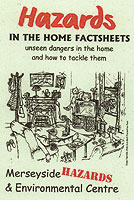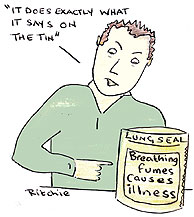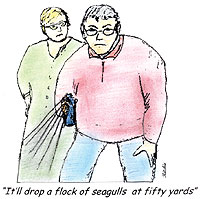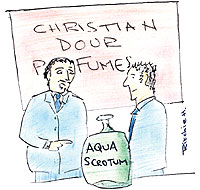
| HOME |
| NERVE |
| REVIEWS |
| ARCHIVE |
| EVENTS |
| LINKS |
| ABOUT US |
| CONTRIBUTORS |
| BACK ISSUES |
| CONTACT US |
 Every year
4,000 people are killed in their homes, and visits to hospital because
of household injuries are measured in the millions. These figures for
sudden death or injury are tragic enough, but what is becoming clearer
are the long term problems to health posed by unseen hazards - from the
chemicals in our homes and the environment.
Every year
4,000 people are killed in their homes, and visits to hospital because
of household injuries are measured in the millions. These figures for
sudden death or injury are tragic enough, but what is becoming clearer
are the long term problems to health posed by unseen hazards - from the
chemicals in our homes and the environment.
Home is Where the Health is?
Alternatives |
They may not be sexy but: |
Pure soaps
are unlikely to contain artificial colourings or perfumes, and are
made from vegetable-based ingredients. They are obtainable from
health food shops. Olive oil is
good for dry skin. |
Alternative pest
control |
Computers |
There is a chemical ‘soup’ in our homes, from pesticides,
paints and plastics; to solvents, stain removers and sanitary products;
to carpet cleaners, conditioners and cosmetics. Add to this the emissions
from gas and electronic equipment and we have a 'time-bomb' of epidemic
proportions.
You may think that this is ‘going a bit over the top’, but
don't forget that the dangers of asbestos were known for decades before
it was banned and tobacco companies know that smoking causes cancer yet
still sell cigarettes.
Companies only test individual chemicals for potency, not their combined
effect - and not much is known about the long-term effects of the build-up
of substances in the body.
For most everyday hazards in the home there are alternatives. But there
is also massive pressure for people to conform to the modern ideal and
lifestyle, from companies in pursuit of profit who bombard us with advertising
and promotions, pushing us into buying the latest powerful cleaners, "anti-bacterial"
sprays etc, and play on people’s fears about hygiene, or not having
a "spotless home". There has been a rise in chronic disease,
which is directly linked to the use of industrial cleaning chemicals,
women who work at home having a 54% higher death rate from cancer than
those who work outside the home.
Also, the routine use of "anti-bacterial" products decreases
immunity from bugs, rather than protecting us from them.
 The
modern bathroom resembles a chemist shop - overflowing with lotions and
potions. The big companies make more and more exotic concoctions to keep
us buying their products. Most are not needed and there are safer, cheaper
alternatives anyway. Toothpaste is a worrying example. The list of chemicals
in most toothpastes is straight out of Dr Jekyll’s lab. And we put
this in our mouths!
The
modern bathroom resembles a chemist shop - overflowing with lotions and
potions. The big companies make more and more exotic concoctions to keep
us buying their products. Most are not needed and there are safer, cheaper
alternatives anyway. Toothpaste is a worrying example. The list of chemicals
in most toothpastes is straight out of Dr Jekyll’s lab. And we put
this in our mouths!
Fluoride - which until the 1930s was considered a poison - is found in
most toothpastes.
Fewer than a quarter of the chemicals used in toiletries and cleaning
products have been subjected to a full safety investigation, while others
- officially classed as hazardous - are found in products from baby lotion
to eye drops and cleaning fluids. Chemicals banned in other more tightly
controlled areas are still commonly used in thousands of household products.
The cosmetics and toiletries industry uses around 6-8,000 ingredients.
Up to 20% of these can cause health problems, but for reasons of commercial
secrecy manufacturers do not have to list them all on their product labels.
The Government has bowed to the £250 billion chemical industry’s
fight against tighter restrictions.
A third of all allergies are caused by fragrances. Perfumes sometimes
contain cruelly-derived ingredients from animals, such as musk, or from
flowers picked by children in poorer countries.
The fashion to have a year round tan has led to excessive use of self
tan products. Many of these contain chemicals such as tyrosine (an amino
acid), used as a ‘tanning accelerator’. The US Federal Drug
Agency has said this is an unapproved drug.
Skin-care experts say we overuse moisturisers. They're supposed to keep
moisture in and protect our skin from environmental pollution. But anti
perspirants and deodorants stop the natural function of the body, preventing
you from getting rid of toxins by sweating them out.
Skin has its own way of staying healthy. If you eat a healthy diet and
drink plenty of water then skin and hair look after themselves, to a large
extent.
 There
are obvious hazards from appliances such as fires, gas leaks (carbon monoxide
kills nearly 1,000 people every year), or electric shock. But there are
longer term unseen problems that have not had as much publicity. These
are the electrical fields and microwaves given off by equipment which
on their own are bad enough, but when combined with chemicals are unmeasurable.
There
are obvious hazards from appliances such as fires, gas leaks (carbon monoxide
kills nearly 1,000 people every year), or electric shock. But there are
longer term unseen problems that have not had as much publicity. These
are the electrical fields and microwaves given off by equipment which
on their own are bad enough, but when combined with chemicals are unmeasurable.
About 125,000 homes in the UK could have high levels of electromagnetic
radiation in them and 80% of these are not even close to pylons. This
is because modern homes have so many electrical appliances. Electrical
charges react with pollutants already in the air allowing chemicals to
penetrate the body more easily, and children's bedrooms are packed with
electrical equipment!
Electromagnetic fields (EMFs) are created wherever there is a flow of
electricity. Concerns surround a possible link between EMFs and problems
with the reproductive system, the immune system and the brain and central
nervous system. They have also been linked to cancers such as leukaemia.
Sensitivity to EMFs is similar to chemical sensitivity, with much the
same allergic reaction.
All electrical equipment and wiring circuits emit EMFs, so it is best
to be cautious and minimise exposure to them whenever possible. Walls
don't significantly reduce them either, but they do drop off with distance,
so ensure that places where you spend long periods of time are at least
four feet from appliances that are working. Equipment still gives off
radiation when on stand-by.
The recognised dangers of computers are eyestrain, Repetitive Strain Injury
(RSI) and back problems because of poor workstation arrangements. But
Gunni Nordstrom - a journalist from Sweden - has also uncovered the hidden
hazards, such as the skin and eye problems caused by x-ray and ultra-violet
light given off by screens. On top of this a recent study reported in
the Journal of Epidemiology found that 32% of workers using computers
are suspected of having glaucoma - a disease that can cause blindness.
 Seventy
people die each year while carrying out DIY jobs, and as many as 250,000
injuries are bad enough to be reported to doctors. Other injuries - caused
by the materials used in home decorating, in fittings and furniture -
may not be so obvious.
Seventy
people die each year while carrying out DIY jobs, and as many as 250,000
injuries are bad enough to be reported to doctors. Other injuries - caused
by the materials used in home decorating, in fittings and furniture -
may not be so obvious.
Carpets can contain heavy metals, pesticides and PCBs (polychlorinated
biphenyls). They also contain colonies of dust mites.
Vinyl linoleum (not to be confused with real linoleum, made from natural
products) is a major source of PVC (polyvinyl chloride), which is linked
to emissions of deadly dioxin. Other chemicals found in vinyl include
phthalates, linked to hormone disruption.
Children are most at risk because they play on the floor and they inhale
23 times as much air as adults, weight for weight.
Most modern furniture is made of pressed wood products that emit chemicals
which can be toxic. MDF (Medium Density Fibreboard) contains the carcinogenic
chemical formaldehyde, and it doesn't have to be cut to release its toxic
fumes.
Solvents can be found in paints, carpets, glues, fabrics and chipboard.
There is a bewildering number of solvents and most are highly toxic.
As paint, paint thinners and removers dry, dangerous fumes called Volatile
Organic Compounds (VOCs) are given off.
Most pest killers contain deadly chemicals and should be used only as
a last resort.
The use of these pesticides in the home is linked with some childhood
cancers such as leukaemia.
Companies producing these products know that they are harmful, but absolve
themselves of any blame by putting a warning on the label.
There is a balance to be struck for most people, between living more healthily
and what they can afford or is easily available. Some alternatives may
cost more money at first, but work out cheaper in the long run.
The only way we can guarantee our safety in the long term is to aim for a fairer system based on people’s needs, not profit. Doing something to make you and your family healthier is possible, but a change in the way society works is needed if we are to live in a genuinely healthy environment.
The next issue of Nerve will have the second article in this series, on food.
Hazards in the Home Factsheets:
Food Chemical
Residues (PDF - 56KB)
Food Additives
(PDF - 79KB)
Food - Meat and
Fish (PDF - 98KB)
Food - Drinks (PDF
- 101KB)
Cleaning Products
(PDF - 85KB)
Bodycare - Bathroom
(PDF - 109KB)
Bodycare - Cosmetics
(PDF - 92KB)
Bodycare
- Sanitary Protection (PDF - 176KB)
Indoor Air Pollution
(PDF - 262KB)
Indoor Air
Pollution - DIY (PDF - 132KB)
Indoor
Air Pollution - Pests (PDF - 105KB)
Recycling (PDF - 119KB)
References:
The Royal Society for the Prevention of Accidents: www.rospa.org.uk
Greenpeace: www.greenpeace.org.uk/Products/Toxics/
Ethical Consumer Magazine: www.ethicalconsumer.org
Karen Christensen (2000) Eco Living - A Handbook for the 21st Century,
Piatkus, London
Rachel Carson (2000, 1st published 1962) Silent Spring, Penguin, London
The Pesticide Action Network UK: www.pan-uk.org
Friends of the Earth, 0808 800 111: www.foe.co.uk
Valerie Ann Worwood (1991) The Fragrant Pharmacy, Bantam Books, London
Pat Thomas, Cleaning Yourself to Death (2001) Newleaf, Dublin
Powerwatch, 0897 100 800: www.powerwatch.org.uk
Gunni Nordstrom, The Invisible Disease (2004) O Books, Hants
The Environmental Working Group: www.ewg.org